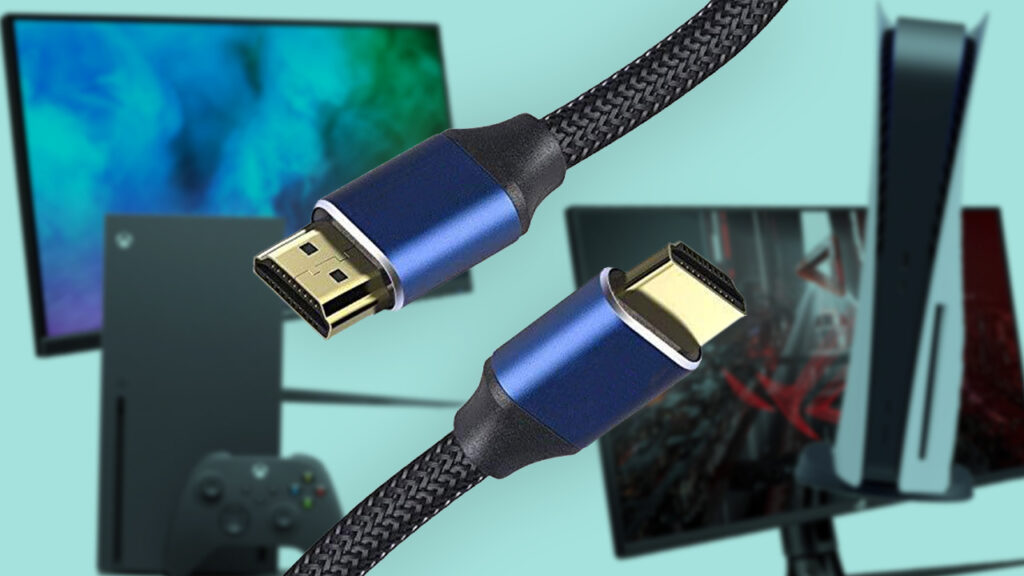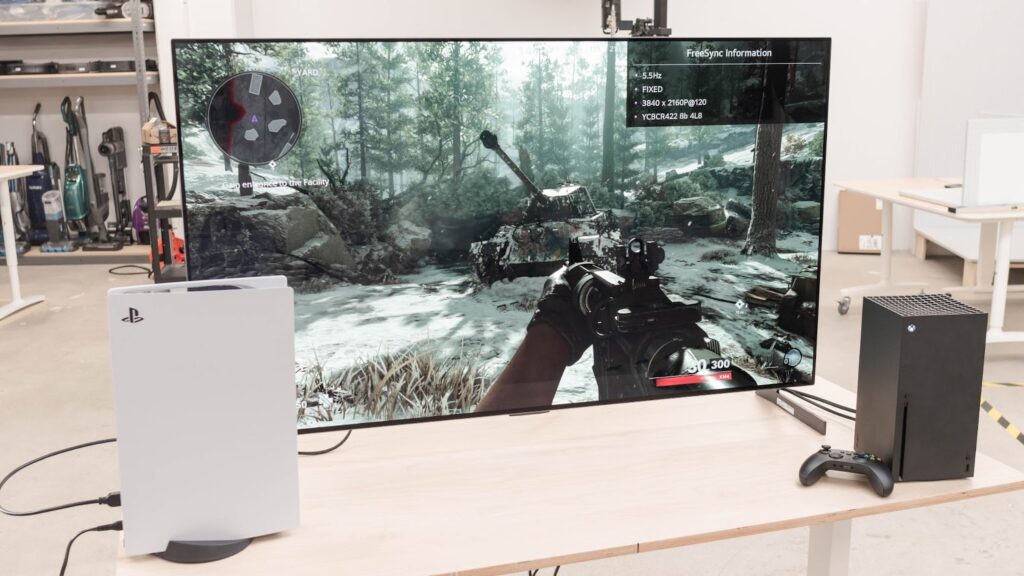HDMI 2.1 has emerged as a game-changer in the ever-evolving world of audiovisual technology.Â
The HDMI 2.1 max refresh rate is the highest frame-per-second capability supported by HDMI 2.1. Unlike its predecessor, HDMI 2.0, which typically supports a maximum of 60Hz at 4K resolution, HDMI 2.1 enables refresh rates of up to 120Hz at 4K resolution.
In this comprehensive guide, we delve into the intricacies of HDMI 2.1 refresh rate and how that affects our real-life applications.
Table of Contents
What is the Refresh Rate? Â
Refresh rate refers to the number of times per second an image is redrawn on a display. It is a critical parameter that greatly influences the visual experience on your screen, whether you’re watching movies, playing games, or working on your computer. Â

A higher refresh rate typically leads to smoother and more fluid visuals.Â
Common refresh rates you might have encountered include 60Hz and 120Hz. A 60Hz display refreshes the image 60 times per second, while a 120Hz display refreshes it 120 times per second.Â
The difference in perceived smoothness can be especially noticeable when gaming or watching fast-paced action scenes.
HDMI 2.1 Max Refresh Rate Â
The maximum refresh rate represents the highest number of frames per second a display or device can handle when connected through HDMI 2.1. In simpler terms, it determines how quickly a display can refresh the image it shows, resulting in smoother motion and improved overall visual quality.
In the context of HDMI 2.1, the max refresh rate refers to the highest number of times per second that an image can be refreshed or redrawn on the screen when connected via an HDMI 2.1 interface. Â
HDMI 2.1 can support a maximum refresh rate of 120Hz at 4K resolution and a staggering 240Hz at 1080p resolution. This is a significant leap from HDMI 2.0, which was limited to 60Hz at 4K resolution.Â
Let’s break down what this means for various applications:
- 4K Content: When viewing content in 4K resolution, HDMI 2.1 allows for a maximum refresh rate of 120Hz. This translates to a smoother and more fluid viewing experience for movies, TV shows, and other high-resolution content. It’s particularly advantageous for those with 120Hz-capable 4K displays.Â

- High-Frequency Gaming: For gamers, HDMI 2.1’s support for a 240Hz refresh rate at 1080p resolution is a game-changer. This means that fast-paced gaming becomes exceptionally smooth, reducing motion blur and enhancing overall gaming performance. Competitive gamers, in particular, benefit from the increased responsiveness and fluidity.

- Variable Refresh Rate (VRR): HDMI 2.1 also introduces features like Variable Refresh Rate (VRR), which synchronizes the refresh rate of the display with the frame rate output of the graphics card. This helps eliminate screen tearing and stuttering, ensuring a tear-free and smooth gaming experience.
- Future-Proofing: HDMI 2.1’s high refresh rate capabilities are designed to future-proof your entertainment and gaming setup. As content and technology continue to evolve, having a display and devices that support HDMI 2.1 ensures you can make the most of the latest advancements.
Factors that Affect Refresh Rate
Several factors can affect the refresh rate of a display, including:
- Display Hardware: The monitor or TV itself plays a crucial role. High-end gaming monitors and OLED TVs, for example, tend to support higher refresh rates compared to budget displays.
- Graphics Processing Unit (GPU): The GPU in your device must also support the desired refresh rate. High-performance GPUs can handle higher refresh rates more effectively, ensuring a smoother experience.
- Resolution: The resolution of the content being displayed can impact the achievable refresh rate. Higher resolutions may require more data to be processed, potentially limiting the refresh rate.
- Connection Standard: The HDMI version used to connect your device to the display is essential. Older HDMI versions might not support high refresh rates. This is where HDMI 2.1 comes into play.
HDMI 2.1 vs. 2.0: Bridging the Bandwidth Gap Â

Comparison Table of HDMI 2.0 and HDMI 2.1
| Feature | HDMI 2.0 | HMDI 2.1 |
| Max Resolution | 4K | 4K and 8K |
| Max Data Rate (Gbps) | 18.0 | 48.0 |
| Dynamic HDR | No | Yes |
| Enhanced Audio Return | No | Yes |
| Refresh Rate | 60Hz (4K) | 120Hz (4K) – 60Hz (8K) |
| Variable Refresh Rate | No | Yes |
| Dolby Vision | Yes | Yes |
| Quick Media Switching | No | Yes |
| Game Mode VRR | No | Yes |
| HDMI Ethernet Channel | Yes | No |
Why HDMI 2.1 Refresh Rate Matters for GamingÂ
HDMI 2.1 refresh rate is a game-changer for gamers designed to complement next-generation consoles and high-end graphics cards. Here’s why it matters:

- Smoother Gameplay
One of the most important benefits of HDMI 2.1’s increased max refresh rate is smoother gameplay. Previous HDMI versions, like HDMI 2.0, supported refresh rates up to 60Hz at 4K resolution. In contrast, HDMI 2.1 pushes the envelope by allowing for refresh rates of up to 120Hz at 4K. This means that in fast-paced games, the screen can update itself twice as often per second, resulting in significantly smoother motion.
For gamers, this translates to more responsive controls, reduced input lag, and an overall more enjoyable gaming experience. Rapid movements in games, such as first-person shooters or racing games, become more fluid and lifelike. This smoother gameplay can be the difference between victory and defeat in competitive gaming.
- Reduced Motion Blur
Higher refresh rates will also help reduce motion blur. This is a common issue in fast-paced games. Motion blur happens when an object on the screen moves too quickly, and the display struggles to keep up, causing the image to blur. With HDMI 2.1’s 120Hz support, motion blur becomes less noticeable, allowing gamers to track fast-moving items and characters more effectively.
In esports, where every millisecond counts, this reduction in motion blur can be a game-changer. Players can react more quickly to in-game events and make split-second decisions with greater precision.
- Future-Proofing for Next-Gen Consoles
The gaming industry is constantly evolving, and with the release of next-generation consoles like the PlayStation 5 and Xbox Series X, game developers are pushing the boundaries of graphics and performance. These consoles are designed to take full advantage of HDMI 2.1, offering 4K gaming at 120Hz or even 8K gaming at 60Hz.
Investing in a display with HDMI 2.1 support ensures that you’re ready for the future of gaming. As game developers continue to push the limits of what’s possible, HDMI 2.1 provides the necessary bandwidth to deliver stunning visuals and higher refresh rates, guaranteeing that your gaming experience remains cutting-edge for years to come.
- Enhanced Visuals
While the refresh rate is primarily about motion, it also contributes to overall visual quality. With HDMI 2.1’s support for 4K resolution at higher refresh rates, games look crisper and more detailed. HDMI 2.1 helps bridge the gap between what you see on the screen and what you experience in the game, making the virtual world more engaging and believable.
Final Thoughts
The HDMI 2.1 max refresh rate represents a significant advancement in the world of audio and video connectivity. With support for refresh rates up to 120Hz at 4K and 240Hz at 1080p, HDMI 2.1 brings unparalleled smoothness and realism to your favorite content.Â
However, to fully utilize this potential, it’s crucial to have compatible hardware, including a display that supports HDMI 2.1 and a capable GPU. As technology continues to evolve, HDMI 2.1 sets the stage for immersive entertainment and gaming experiences that were once unimaginable.Â
So, whether you’re a gamer, a cinephile, or simply an enthusiast for high-quality visuals, HDMI 2.1 is a game-changer that deserves your attention.
FAQs
1. What is HDMI 2.1?
HDMI 2.1 is the latest version of the High-Definition Multimedia Interface standard. It introduces several enhancements over previous versions including higher bandwidth and support for advanced features like 10K resolution and dynamic HDR.
2. Do I need a special cable for HDMI 2.1?
Yes, to fully utilize HDMI 2.1 features you will need a compatible cable specifically an Ultra High-Speed HDMI cable. Older HDMI cables may not support the increased bandwidth of HDMI 2.1.
3. What resolutions does HDMI 2.1 support?
HDMI 2.1 can support resolutions up to 10K although 8K and 4K at higher refresh rates are more commonly encountered in today’s content and displays.
4. Is HDMI 2.1 backward compatible with older HDMI versions?
Yes, HDMI 2.1 is backward compatible with devices that use older HDMI versions. However, you won’t be able to access the new features of HDMI 2.1 unless both the source device and the display support it.
5. Are there any 10K content or displays available for HDMI 2.1?
As of now, there is limited 10K content and displays on the market. However, HDMI 2.1 is designed to be future-proof, ensuring that it can handle upcoming advancements in resolution and content.
6. Can I use HDMI 2.1 for non-gaming applications?
Absolutely. HDMI 2.1 is not limited to gaming. It enhances the overall audiovisual experience for all types of content including movies, TV shows, and professional applications that demand high resolution and fast refresh rates.
7. Is HDMI 2.1 necessary for everyday use, or is it primarily for enthusiasts?
While HDMI 2.1 offers advanced features that enthusiasts may appreciate it can also benefit everyday users who seek higher-quality audio and video experiences especially as more content becomes available in 4K and 8K formats.
Video Conference Network Record And Stream Server
Av Over Ip System,Wireless Wifi Cameras,Outdoor Wireless Wifi Cameras,Streaming And Recording Hdmi Video
SZ REACH TECH,.CO LTD , https://www.szreachtech.com